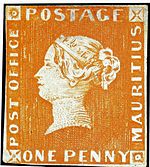Mauritius "Post Office" stamps
| Mauritius "Post Office" Stamps | |
|---|---|
 
|
|
| Country of production | Mauritius |
| Date of production | 21 September 1847 |
| Depicts | Queen Victoria |
| Nature of rarity | First British Empire stamps produced outside Great Britain |
| No. in existence | 27 (as of 1981) |
| Face value |
|
| Estimated value | $4 million both on cover (last sale, 1993) |
The Mauritius "Post Office" stamps were issued by the British Colony Mauritius in September 1847, in two denominations: an orange-red one penny (1d) and a deep blue two pence (2d). Their name comes from the wording on the stamps reading "Post Office", which was soon changed in the next issue to "Post Paid." They are among the rarest postage stamps in the world.
They were engraved by Joseph Osmond Barnard, born in England in 1816, who stowed away on a ship to Mauritius in 1838. The designs were based on the then current issue of Great Britain stamps (first released in 1841), bearing the profile head of Queen Victoria and issued in two denominations in similar colours: one penny red brown and Two pence blue. Although these locally produced stamps have a distinct primitive character, they made Barnard’s “name immortal in the postal history of Mauritius”.
Five hundred of each value were printed from a single plate bearing both values and issued on September 21, 1847, many of which were used on invitations sent out by the wife of the Governor of Mauritius for a ball she was holding that weekend. The stamps were printed using the intaglio method (recessed printing), and bear the engraver's initials "JB" at the lower right margin of the bust.
The words "Post Office" appear in the left panel, but on the following issue in 1848, these words were replaced by "Post Paid." A legend arose later that the words "Post Office" had been an error.
The stamps, as well as the subsequent issues, are highly prized by collectors because of their rarity, their early dates and their primitive character as local products. Surviving stamps are mainly in the hands of private collectors, but some are on public display in the British Library in London, including the envelope of an original invitation to the Governor's ball complete with stamp. Two other places where they can be seen, in Mauritius, are at the Postal Museum and at the Blue Penny Museum, both in Port Louis, the capital city. The two stamps also can be seen at the Museum for Communication (Museum für Kommunikation) in Berlin and in the Postal Museum of Sweden in Stockholm. A two pence blue is also at display at the Museum for Communication (Museum voor Communicatie) in The Hague.
...
Wikipedia
